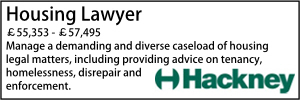Building Safety Charges – five things you need to know
- Details
Douglas Rhodes sets out some key points for local authority landlords ahead of major reforms to the law of service charges.
In July 2020 the government published the draft Building Safety Bill. The draft Bill is the latest and most significant step yet taken towards implementing the Hackitt Review, which recommended fundamental reforms to the regulation of building safety.
The reforms will cover higher-risk residential buildings, which are expected to be defined as buildings of more than six storeys or 18 metres in height, although this threshold may be reduced over time. Amongst other things, the draft Bill implements the most significant reform of the law of service charges for almost 20 years, by introducing the new concept of building safety charges. Here are five things you need to know about them.
1. A new category of service charges
The draft Bill amends the Landlord and Tenant Act 1985 by inserting no less than 24 new provisions. These create the concept of building safety charges, which is a new category of service charges that landlords of higher-risk residential buildings shall be entitled to demand from long leaseholders to recover building safety costs. Building safety costs are defined by the draft Bill as including the costs incurred or to be incurred by or on behalf of an accountable person for a higher-risk building in connection with the carrying out of prescribed building safety measures.
The regulations that will set out the prescribed building safety measures are yet to be published but it is expected that these will include the various measures introduced by the draft Bill. These include the assessment of building safety risks, the appointment of a building safety manager, the preparation and registration of a building safety case with the Building Safety Regulator, the implementation of works identified as necessary when registering the building safety case, mandatory incident reporting and the implementation of a formalised resident engagement strategy.
2. Implied covenants in long leases
The draft Bill implies new terms into long leases of dwellings in higher-risk buildings. These include an implied covenant on the landlord (where it is an accountable person) to carry out the prescribed building safety measures in relation to the building. In addition to potential regulatory enforcement action by the Building Safety Regulator if building safety measures are not undertaken, the County Court shall have jurisdiction to order specific performance of the implied covenants if landlords fail to comply.
The good news for local authority landlords is that there will be a corresponding implied covenant imposed upon the tenant of a long lease to pay building safety charges within 28 days of a demand and to provide access to the landlord for the purpose of carrying out building safety measures or for inspection purposes. This should ensure that where landlords undertake building safety measures they will have the ability to recover those costs and to access dwellings where needed, regardless of the wording of the particular lease.
3. New accounting requirements
The draft Bill introduces various new accounting obligations upon landlords. Before each accounting period a building safety budget will need to be served, providing an estimate of the building safety charges to be payable by the tenant. If additional building safety costs beyond the budgeted costs are to be incurred, a separate budget needs to be provided before those costs can be demanded.
Any amounts received from tenants in respect of building safety charges will be held on trust and must be placed in a designated bank account for that purpose. There is no exemption in the draft Bill for local authority landlords and it remains to be seen whether the regulations that accompany the Bill will relax these rules for local authorities, as is the case with the existing duties under the Landlord and Tenant Act 1987 to hold service charge monies in trust.
Within 28 days of the end of each accounting period, the landlord will need to provide a reconciliation account specifying what measures were carried out, the budgeted costs that were incurred (and not incurred), the total amount of building safety charges due, the total sums received, and the total sums remaining in the designated account.
4. Reasonableness and consultation
As with existing service charges, building safety charges shall only be payable to the extent that they are reasonably incurred and only if the services or works are of a reasonable standard. Tenants will have the ability to challenge the reasonableness of building safety charges at the First-tier Tribunal (Property Chamber) in the same way as with service charges.
New consultation requirements are also being introduced, which will be similar to existing section 20 requirements, including the ability to apply to the First-tier Tribunal for dispensation. There are some notable differences however, such as an urgent cases procedure that will allow landlords to serve an exemption notice where works are required to be undertaken pursuant to a compliance notice or an urgent action notice issued by the Building Safety Regulator.
5. Major procedural change
Although the Building Safety Bill is still in draft form and may change before it becomes law, it is expected to come into force towards the end of 2021. It is clear from the draft Bill that major procedural changes will be required on the part of landlords when setting service charge budgets and recovering costs. Local authority landlords should review their service charge recovery and accounting procedures now in order to understand what changes will be required when the new rules come into force.
The obligation to produce a separate building safety charge budget and the new consultation requirements introduced for building safety charges will create significant regulatory burdens on council departments that are responsible for service charge recovery. However, with adequate preparation and stress-testing of existing procedures compared with the new regime, the implied covenant on tenants of long leases to pay building safety costs means that local authority landlords should find that they are able to approach costs recovery for building safety works with a greater degree of confidence than before.
Douglas Rhodes is a partner in the property litigation team at Trowers & Hamlins LLP. He can be contacte on 020 7423 8343 or
Must read
Fix it fast: How “Awaab’s Law” is forcing action in social housing
Housing management in practice: six challenges shaping the sector
Why AI must power the next wave of Social Housing delivery
Sponsored articles
Walker Morris supports Tower Hamlets Council in first known Remediation Contribution Order application issued by local authority
Unlocking legal talent
09-12-2025 1:00 pm
11-12-2025 11:00 am







































